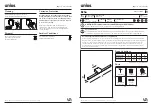
Dla zapewnienia bezpieczeństwa przed przystąpieniem do montażu
należy się zapoznać z niniejszą instrukcją. Instrukcję należy zachować.
Oprawę oświetleniową, której dotyczy ta instrukcja należy używać
zgodnie z jej przeznaczeniem.
Instalowa
ć
oprawy mogą tylko osoby do tego przeszkolone
i posiadające odpowiednie uprawnienia
1. Producent ma wyłączne prawo do modyfikacji swoich wyrobów.
2. Podczas montażu opraw stosować dołączone do oprawy rękawiczki
ochronne.
3. Producent nie ponosi odpowiedzialności za:
- szkody wynikłe po modyfikacji wyrobu przez użytkownika,
- uszkodzenia wyrobu powstałe w wyniku instalacji niezgodnie
z instrukcją montażu przez osoby nieuprawnione lub w wyniku
niewłaściwego składowania,
- zabrudzenie wyrobu podczas montażu z powodu nie stosowania
rękawiczek ochronnych.
Uwaga:
Opraw w wykonaniu podstropowym nie okrywać matą
izolacyjną.
Konserwacja
W czasie eksploatacji oświetlenia należy dokonywać oględzin opraw, w
celu wykrywania awarii i uszkodzeń mechanicznych oraz zabrudzeń
szczególnie elementów układu optycznego.
1. Przed przystąpieniem do oględzin oprawy wyłączyć jej zasilanie.
2. Elementy oprawy które podczas normalnej eksploatacji ulegną zużyciu
lub uszkodzeniu należy bezzwłocznie wymienić na nowe, pozbawione
wad.
3. Obudowę oprawy oraz jej elementy (szybę, powierzchnie lakierowane)
można czyścić płynami ulegającymi biodegradacji przy pomocy miękkich
ściereczek a po usunięciu zabrudzenia osuszyć (suszarką lub wytrzeć
ściereczką). Powierzchnie PLX oraz PRM, rastry, odbłyśniki - odmuchać
sprzężonym powietrzem.
Oprawy nie zagrażają bezpieczeństwu ludzi i mieniu pod
warunkiem, że są właściwie zainstalowane, utrzymywane i użytkowane
zgodnie z przeznaczeniem. Oprawy nie są przeznaczone do użytku
domowego.
Stosowanie opraw oświetleniowych
Oprawy oświetleniowe przeznaczone są do
pracy w normalnych warunkach, z wyjątkiem opraw o przeznaczeniu
o
specjalnym. Warunki normale charakteryzuje temperatura otoczenia 25 C,
ciśnienie 1000 hPa, wilgotność 40 - 60%. Są to warunki panujące na
przeważającym terenie strefy europejskiej.
Opraw nie należy stosować w przypadku gdy warunki otoczenia mogą
zagrozić konstrukcji oprawy, powłoce lakierniczej lub komponentom
elektroniczym umieszczonym w środku powodując nieprawidłowe
działanie oprawy.
Do czynników zagrażających można zaliczyć min.: wysoka temperatura,
wysoka wilgotność, zapylenie, obecność w powietrzu substancji
chemicznie nieobojetnych (chlor, sól, kwasy, zasady), wibracje,
zgodnie z ich przeznaczeniem. Muszą być instalowane zgodnie z instrukcją
montażową, wyłącznie przez osoby posiadające odpowiednie uprawnienia.
Oprawy oświetleniowe służa do oświetlania pomieszczeń
i powierzchni.
wstrząsy
,
narażenie na udar, UV, pole elektromagnetyczn. Oprawy należy stosować
Uwaga:
W oprawach z przesłoną PLX, PRM, MPRM, SH niedoposzczalne jest
montowanie ramki z przesłoną poprzez dociskanie przesłony!
For safety reasons, it is necessary to read these instructions before
starting the assembly. The instructions should be kept for future purposes.
The fitting being the subject of these instructions must be used according
to its original purpose.
Fittings can be installed only by persons who are trained and duly
authorized to do so.
1. The Producer has the exclusive right to introduce modifications to the
product.
2. During the assembly of the fittings it is necessary to use the disposable
gloves enclosed in the packaging.
3. The Producer shall not be held liable for the following:
- damages which occur after the product has been modified by a user,
- damages to the productresulting from installation not carried out in
compliance with the instruction for assembly, installation by unauthorized
persons or damages resulting from unsuitable storage,
- the product getting dirty during assembly, if the person carrying out
the assembly does not wear disposable gloves.
Notice:
Ceiling-type fittings must not be covered with an insulating mat.
Maintenance
During the exploitation period of lighting it is necessary to inspect
the fittings in order to detect malfunctions and mechanical damages, as
well as impurities, in particular those of elements in the optical system.
1. Before proceeding to the inspection of a fitting, the power supply must
be turned off.
2. Elements of the fitting which get used up or damaged in the course of
standard exploitation must immediately be replaced with new and defect-
free elements.
3. The fitting and its elements (glass, painted surface) can be cleansed
with biodegradable liquids using soft washcloth and after removing
impurities they need to be dried (with a dryer or wiped with a dry
washcloth). PLX and PRM surfaces,MPRM rasters, reflectorsshould be
blown over with compressed air. Lighting fixtures used to illuminate the
premisesand the surface.The fittings do not pose any threats to the safety
of humans or property, provided that they are properly installed,
maintained and used in compliance with their original purpose.
Luminaires are not intended for home use.
The use of lighting fittings
Lighting fittings are aimed for
use in standard conditions, with the exception of special-purpose fittings.
Standard conditions are featured by ambient temperature of 25°C,
pressure of 1000 hPa, andhumidity of 40 - 60%. Suchconditionsprevail on
the Europeanterritory. The fittings should not be used, if the
environmental conditions could harm the structure of a fitting, top coats or
electronic component partsplaced inside the fitting, causing malfunction
of the fitting.
The risks factors include i.a. high temperature, excessive humidity,
dustiness, the presence of chemically significant substances in the
atmosphere (chlorine, salt, acids, alkali), vibrations, shock, exposure to
shock, UV radiation, electromagnetic fields. The fittings must be used
according to their original purpose. They must be installed according to
the installation instructions, solely by persons authorized to do so.
Notice:
In luminaries with the following diffusers: PLX, PRM, MPRM, it’s not
allowed to assembly a frame with diffuser by pressing the surface of
diffuser.
It may result with the diffuser and IP damage.
Um ein hohes Maß an Sicherheit zu gewährleisten, ist es nötig, sich
vor Beginn der Montage mit dieser Gebrauchsanweisung vertraut zu
machen. Diese Gebrauchsanweisung soll man aufbewahren.
Die in der Anweisung beschriebene Leuchte soll nur nach ihrem
Verwendungszweck gebraucht werden.
Die Leuchten können nur von den Personen installiert werden, die zu
diesem Zweck ausgebildet sind und die richtige Befugnisse haben .
1. Nur der Hersteller hat das Recht, seine Produkte zu ändern.
2. Während des Einbaus der Leuchte soll man die angeschlossene
Schutzhandschuhe benutzen.
3. Der Hersteller haftet nicht für:
- Schäden, die nach der Produktänderung von dem Nutzer verursacht
werden,
- Produktschäden, die durch Einbau, der den Hinweisen nicht
entspricht, Einbau durch unberechtigte Personen oder durch unkorrekte
Lagerung verursacht sind,
- Verschmutzung der Produkte während des Einbaus, wenn keine
Schutzhandschuhe benutzt wurden.
Achtung:
Die Deckenleuchten sollen nicht mit einer Isolliermatte
zugedeckt werden.
Instandhaltung
Während des Betriebes der Beleuchtung ist es nötig, die Leuchte zu
besichtigen, um die Ausfälle, mechanische Beschädigungen und
Verschmutzungen zu finden, vor allem in den Elementen der optischen
Anordnung.
1. Vor Beginn der Besichtigung der Leuchte ist es nötig, die Energiequelle
auszumachen.
2. Die Leuchteelemente, die im Normalbetrieb völlig verbraucht oder
beschädigt werden, sollen sofort durch die neuen Elemente ohne Fehler
ersetzt werden.
3. Gehäuse der Leuchte und seine Elemente (die Scheibe, lackierte
Flächen) können mit biologisch abbaubaren Flüssigkeiten und Spültücher
gereinigt werden. Nach Reinigung sollen sie abgetrocknet werden (mit
einem Trockner oder Spültücher). Die PLX und PRM Flächen, MPRM
Raster, Reflektoren sollen mit Druckluft geblasen werden.
Die Leuchten sind für Menschen und Vermögen nicht gefährlich,
vorausgesetzt, dass sie richtig eingebaut, instand gehalten und nach dem
Verwendungszweck gebraucht werden. Die Leuchte sind nicht für den
häuslichen Gebrauch bestimmt.
Anwendung der Leuchten
Die Leuchten mit einem
besonderen Zweck, sollen unter normalen Bedingungen arbeiten. Die
normale Bedingungen sind Umgebungstemperatur von 25° C, Luftdruck
von 1000 hPa und Luftfeuchtigkeit von 40 - 60%. Solche Bedingungen
herrschen fast im ganzen Gebiet Europas.
Die Leuchten sollen nicht gebraucht werden, wenn die Bedingungen in
der Umgebung der Konstruktion der Leuchte, dem Läckbelag oder den
elektronischen Komponenten, die sich drin befinden, schaden könnten
und dadurch eine unkorrekte Arbeit der Leuchte verursachen.
Als negative Wirkungen kann man u.a. hohe Temperatur, hohe
Feuchtigkeit, Staubgehalt der Luft, chemisch wichtige Stoffe in der Luft
(Chlor, Salz, Säure, Basen), Schwingungen, Schock, UV und
elektromagnetische Felder nennen. Die Leuchten sollen nach ihrem
Verwendungszweck gebraucht werden. Bei dem Einbau soll man nach der
Anweisung vorfahren. Der Einbau soll nur von den dazu berechtigten
Personen durchgeführt werden.
Achtung:
In den Leuchten mit einer PLX, PRM, MPRM, oder SH Blende ist es
nicht erlaubt, den Rahmen mit einer Blende durch Zudrücken der Blende
einzubauen!
PL
GB
DE
4. Montując oprawy należy uwzględnić określone przez producentów
sufitów dopuszczalne parametry nośności i sztywności
tj. obciążenie równomiernie rozłożone oraz obciążenie siłą skupioną.
4.
,
(Concentrated and Unformly Distributed Load)
While mounting luminaries stiffness and carrying capacity provided by
ceiling manufacturers have to be taken into consideration.
4.
Bei der Montage der Leuchten muss man spezifische zulässige
Parameter wie Belastbarkeit und Steifigkeit der Decke berücksichtigen,
die von Deckenproduzenten bestimmt sind. Das bedeutet
gleichmäßig verteilte Last, sowie konzentrierte Kraftbelastung
.
Pour garantir la sécurité avant de monter les luminaires il faut lire
le présent mode d'emploie. Il faut garder le mode d'emploie.
Le luminaire dont on parle dans le présent mode d'emploie doit être
employé conformément à sa destination.
Les luminaires peuvent être montés par des personnes formées et qui ont
des autorisations convenables.
1.
Le producteur a le droit exclusif de modifier ses produits.
2.
Pendant le montage des luminaires il faut mettre des gants de silicone qui
sont joints.
3.
Le producteur n'est pas responsable pour
-
Les dommages causés par la modification du produit par l'usager
-
Les détériorations causées par l'installation qui n'est pas conforme au
mode d'emploie par des personnes qui n'ont pas d'autorisation ou par le
stockage inconvenable,
-
Les salissures du produit pendant le montage à cause de ne pas mettre
des gants de protection.
4.
En montant les luminaires il faut prendre en considération les paramètres
de capacité de charge et de rigidité décrites par des producteurs des
plafonds cela veut dire la charge repartie d'une façon uniforme et la charge
de la force concentrée.
Attention :
Les luminaires montés dans la version sous le plafond ne
doivent pas être couverts par des feutres d'isolement.
L'entretien
Au cours de l'exploitation de l'éclairage Il faut faire des inspections
des luminaires pour trouver des pannes et des dommages mécaniques et des
salissures particulièrement dans les éléments du réseau optique.
1.
Avant de procéder à n'importe quelles activités d'entretient il faut
débrancher l'alimentation.
2.
Les éléments du luminaire qui pendant l'exploitation normale seront
exploités ou endommagés doivent être tout de suite échangés contre les
nouveaux qui sont sans défauts.
3.
Le boîtier du luminaire (vitre, surfaces vernies) peut être nettoyé avec des
produits biodégradables en liquide – Microzoid AF Liquid, AERODESIN
2000, AniosprayQuik, FUGATEN SPRAY, Incidin Liquid Spray, à l'aide
des chiffons doux et après avoir enlever des salissures sécher (à l'aide du
séchoir ou essuyer avec un chiffon). Les surfaces PLX et PRM, les trames,
les réflecteurs – souffler avec l'air comprimé.
Les luminaires servent à éclairer des pièces et des surfaces. Les luminaires
ne sont pas dangereux pour la sécurité des gens et pour les biens à condition
qu'ils soient convenablement installés, entretenus et utilisés conformément
avec leur destination.
L'application des luminaires
Les luminaires sont destinés pour le travail dans des conditions
normales, sauf les luminaires dont la destination est spéciale. Les conditions
normales se caractérisent par la température de l'entourage -10 +25°C, la
pression 960-1000 hectopascal, l'humidité 40-60%. Ce sont des conditions
qui existent dans la plupart du territoire européen.
Le luminaire ne peut pas être appliqué quand les conditions de l'entourage
peuvent endommager la construction du luminaire, la couche du verni ou
les components électroniques placés à l'intérieur en provoquant le mauvais
fonctionnement du luminaire. Les luminaires sont examinés conformément
à la norme EN-60598-1.
Les facteurs de risque ce sont entre autre : la haute température, la haute
humidité, l'empoussièrement, la présence dans l'air des substances
chimiquement qui ne sont pas neutres (chlore, sel, acides, bases), les
vibrations, les secousses, le risque de l'onde de choc, le rayonnement ultra
violet, le champ électromagnétique. Les luminaires doivent être appliqués
conformément à leur destination. Ils doivent être installés conformément à
la notice du montage, exclusivement par des personnes qui possèdent des
autorisations convenables.
Attention :
Dans les luminaires avec le diaphragme PLX, PRM, MPRM, SH il est
inadmissible de monter le cadre avec le diaphragme par serrer le
diaphragme!
.
.
.
FR





















